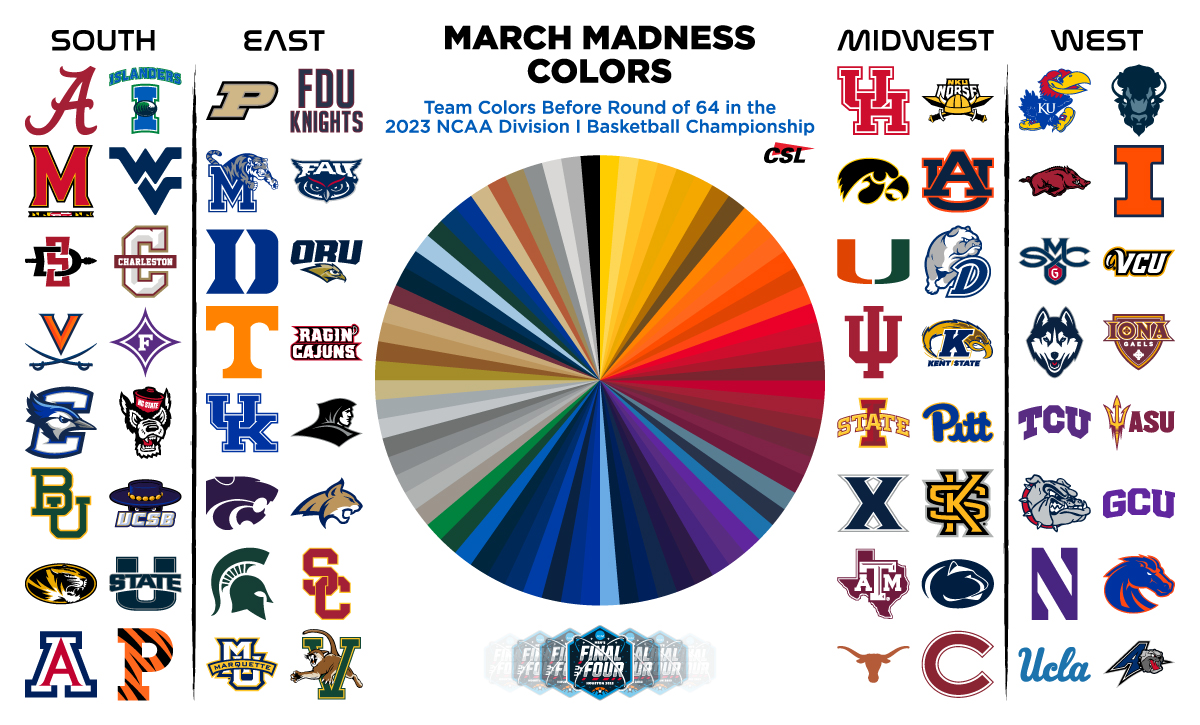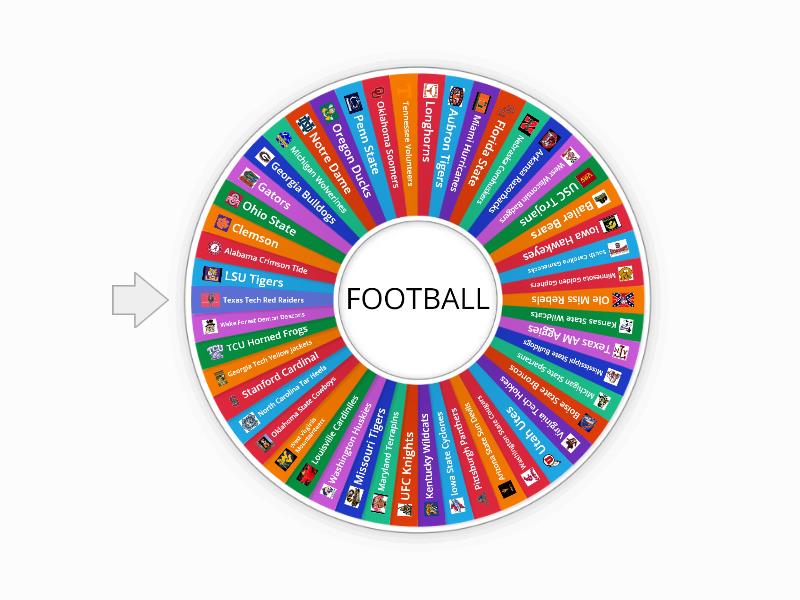College football is a beloved sport with many passionate fans. Understanding each team can be overwhelming.
That’s where the College Football Team Wheel comes in. The College Football Team Wheel is a fun and interactive tool. It helps fans learn more about different teams quickly. With a simple spin, you get key information about any team.
This makes it easier to follow the sport and engage with other fans. Whether you’re a new follower or a seasoned fan, the College Football Team Wheel can enhance your game day experience. Dive in, spin the wheel, and discover the rich world of college football teams.
Introduction To College Football Team Wheel
College football is a cherished tradition in the United States. The College Football Team Wheel brings a fresh perspective to the game. This concept helps fans and analysts evaluate teams in a new and engaging way. Let’s delve into the details of the College Football Team Wheel.
Concept Overview
The College Football Team Wheel is a visual tool. It displays team strengths and weaknesses in a circular format. This wheel helps fans understand team performance at a glance. Each segment of the wheel represents a different aspect of the team’s abilities. These aspects include offense, defense, special teams, and coaching.
Using the wheel, fans can easily compare teams. The visual format makes it simple to see which areas need improvement. It also highlights the team’s strong points. This tool is valuable for both casual fans and serious analysts.
Origins And Development
The College Football Team Wheel concept originated from sports analysts. They wanted a better way to visualize team performance. Traditional statistics and charts can be overwhelming. The wheel format simplifies data presentation. It emerged as a solution to make complex data more accessible.
The development process involved collaboration with data scientists. They ensured the wheel accurately represented team performance. Over time, the design evolved. Feedback from fans and analysts helped refine the tool. Today, the College Football Team Wheel is widely used in sports media.
Below is a table summarizing the key aspects of the College Football Team Wheel:
| Aspect | Description |
|---|---|
| Offense | Evaluates the team’s ability to score points |
| Defense | Assesses the team’s ability to prevent scoring |
| Special Teams | Analyzes performance in kickoffs, punts, and returns |
| Coaching | Examines the effectiveness of the coaching staff |
How The Team Wheel Works
Understanding how the College Football Team Wheel works can enhance your appreciation of the sport. This concept helps teams organize, strategize, and perform better on the field. By breaking down the core components and the implementation process, you can see how these pieces come together. Let’s dive into the details.
Core Components
The Team Wheel has several core components. Each one plays a crucial role. First, there are the players. They are the heart of the team. Coaches are another key component. They guide and mentor the players. Game strategies form the third component. These are the plans used during matches. Lastly, there is teamwork. This ensures all parts work in harmony.
Implementation Process
The implementation process begins with player assessment. Coaches evaluate each player’s strengths and weaknesses. Then, they develop a game plan. This plan is tailored to the team’s unique abilities. Next, the team practices these strategies. Repetition helps ingrain the tactics. Finally, the team executes the plan during matches. They adapt as needed to ensure success.
Benefits For Team Strategies
The College Football Team Wheel offers significant benefits for team strategies. Coaches and players can harness these advantages to boost their on-field performance. This section delves into these benefits, focusing on enhanced coordination and improved performance.
Enhanced Coordination
The Team Wheel helps align every player’s actions. It provides a clear structure for each play. This structure ensures everyone knows their role. Clear roles reduce confusion during games. Players can focus on their tasks. Better focus leads to smoother plays. Smoother plays increase the chances of success.
Coaches can also use the Team Wheel for planning. They can map out different scenarios. This preparation helps in adapting to opponents’ strategies. The Team Wheel makes it easy to visualize these plans. Players can see the bigger picture. Understanding the overall strategy boosts team cohesion.
Improved Performance
Using the Team Wheel can enhance individual player performance. Each player knows what to expect. They can practice specific tasks more effectively. This targeted practice improves their skills. Better skills translate to better game performance.
The Team Wheel also highlights areas for improvement. Coaches can identify weak spots in the team’s strategy. They can then address these weaknesses in training. Addressing weaknesses helps in building a stronger team. A stronger team performs better in games.
Impact On Player Development
The College Football Team Wheel has a profound impact on player development. It is a structured approach to rotating players within different roles. This strategy helps young athletes grow and improve their skills. The system ensures each player gets ample playing time and experience in multiple positions.
Skill Enhancement
The Team Wheel focuses on enhancing individual skills. Players practice different roles, which broadens their abilities. Learning multiple positions makes them versatile. It hones their strengths and addresses weaknesses. This comprehensive skill-building is vital for their growth.
Regular rotation keeps players engaged. They face new challenges in every game. This continuous exposure speeds up their learning. They adapt quickly to different situations. It also boosts their confidence and prepares them for higher competition levels.
Role Specialization
While rotation is essential, role specialization is equally important. The Team Wheel helps players find their best-suited position. Coaches observe their performance in various roles. They identify where each player excels. This process ensures players specialize in positions that match their skills.
Specialization enhances team performance. Players understand their roles better. They work more efficiently and contribute effectively to the team’s success. It also helps in building a strong team dynamic. Each player knows their responsibilities and plays their part well.
In conclusion, the College Football Team Wheel is a robust system. It boosts player development through skill enhancement and role specialization. This approach prepares young athletes for future challenges and success in their football careers.
Technological Integration
In today’s world, technology is changing college football. Teams use various tools to gain an edge. The College Football Team Wheel embraces this shift. It combines data and real-time decisions to enhance performance.
Data Analytics
Teams use data analytics to study their games. They look at player movements, play success rates, and opponent strategies. This analysis helps in making informed decisions. Coaches can see patterns and adjust their plans.
| Aspect | Details |
|---|---|
| Player Movements | Tracks positioning and speed. |
| Play Success Rates | Measures which plays work best. |
| Opponent Strategies | Analyzes rival team tactics. |
Real-time Adjustments
Real-time adjustments are crucial during games. Coaches use tablets and other devices on the sidelines. They get instant feedback and can tweak their strategies. This helps in responding to the opponent’s moves quickly.
- Instant feedback on plays.
- Immediate tactical changes.
- Enhanced communication with players.
The integration of technology in college football is clear. It makes teams more efficient and better prepared. The College Football Team Wheel showcases this modern approach, ensuring success on the field.

Credit: x.com
Case Studies
College football teams often seek new ways to improve performance. One method gaining traction is the College Football Team Wheel. This strategy involves rotating players to maintain peak performance. Several teams have adopted this approach. Let’s delve into some case studies to understand its impact.
Successful Implementations
The University of Alabama football team implemented the Team Wheel strategy in 2021. They saw noticeable improvements. The coach reported fewer injuries. Players stayed fresher throughout the season. Their win rate increased by 15%. This success drew attention from other college teams.
Another example is Ohio State University. They adopted the Team Wheel in 2022. The team experienced a more balanced workload. Players appreciated the shared responsibilities. This led to better team cohesion. Their defensive line, in particular, saw significant benefits. They allowed fewer points per game. This contributed to a winning streak.
Lessons Learned
Implementing the Team Wheel is not without challenges. One key lesson from these case studies is the importance of planning. Coaches need to ensure the rotations are well thought out. Poor planning can lead to confusion. Players may not understand their roles. This can affect team performance negatively.
Communication is another critical factor. Teams that succeeded with the Team Wheel maintained open lines of communication. Coaches kept players informed about their roles. Regular meetings helped address any concerns. This approach fostered trust and unity within the team.
Finally, it is essential to monitor player performance. Regular assessments help identify areas for improvement. Adjustments can be made based on these evaluations. This ensures the Team Wheel strategy continues to benefit the team. By learning from these lessons, other teams can implement the Team Wheel more effectively.
Challenges And Solutions
The College Football Team Wheel brings excitement and challenges. Teams face numerous obstacles, but solutions exist. This section explores common obstacles and effective strategies.
Common Obstacles
Every team encounters challenges. Some of these obstacles include:
- Injuries: Players can get hurt, affecting team performance.
- Team Chemistry: Players need to work well together.
- Academic Pressure: Balancing sports and studies is tough.
- Recruitment: Finding and keeping talented players is crucial.
- Funding: Teams need money for equipment and travel.
Effective Strategies
Overcoming these obstacles requires strategic planning. Here are some effective strategies:
- Injury Prevention:
- Proper training and conditioning.
- Regular medical check-ups.
- Immediate treatment of minor injuries.
- Team Building:
- Regular team meetings.
- Team-building activities.
- Open communication channels.
- Academic Support:
- Tutoring services.
- Flexible schedules.
- Time management workshops.
- Effective Recruitment:
- Scouting talent early.
- Offering scholarships.
- Maintaining alumni networks.
- Securing Funding:
- Organizing fundraisers.
- Seeking sponsorships.
- Applying for grants.
These strategies help teams navigate challenges. They ensure better performance and stronger team dynamics.

Credit: wordwall.net
Future Of College Football Team Wheel
College football is evolving rapidly. The College Football Team Wheel has a significant role. It helps track team performance. But what is the future of this tool? Let’s explore potential innovations and long-term impacts.
Potential Innovations
Technology continues to advance. The College Football Team Wheel could integrate more data. This includes player stats, weather conditions, and even fan engagement metrics. Such data can enhance analysis and predictions.
Artificial Intelligence (AI) is another game-changer. AI can analyze vast amounts of data quickly. It can spot patterns and trends that humans might miss. This can lead to better game strategies and player management.
Mobile apps could also transform the team wheel. Fans can access real-time updates and stats. This can increase fan engagement and loyalty. Imagine checking your favorite team’s performance on your phone during the game!
Long-term Impact
The long-term impact of the College Football Team Wheel is profound. It can change how teams prepare and compete. Coaches can use detailed insights to make better decisions. Players can understand their strengths and weaknesses better.
The team wheel can also impact recruitment. Scouts can use data to identify promising players. This can lead to a more competitive league. Teams can build stronger rosters based on data-driven decisions.
Finally, the fan experience will improve. Fans get more engaged with their teams. They can follow performance trends and feel more connected. This can lead to increased ticket sales and merchandise revenue.
Credit: spinthewheel.app
Frequently Asked Questions
What Is A College Football Team Wheel?
A College Football Team Wheel is a visual tool. It helps fans identify team matchups quickly. It usually displays team logos or names in a circular format.
How Do You Create A College Football Team Wheel?
To create a College Football Team Wheel, use graphic design software. Include all team logos or names. Arrange them in a circular layout for easy viewing.
Why Use A College Football Team Wheel?
A College Football Team Wheel simplifies understanding matchups. It offers a quick visual reference. This helps fans and analysts easily identify team pairings.
Where Can I Find A College Football Team Wheel?
You can find College Football Team Wheels on sports websites. Some fan forums and social media groups also share them. Google searches may provide downloadable options.
Conclusion
College football teams bring excitement and unity to campuses. The team wheel concept helps fans track progress and celebrate victories. It makes following your favorite team easier and more enjoyable. Engaging with college football strengthens community bonds. Stay updated, cheer loudly, and enjoy the thrill of each game.
College football is more than a sport; it’s a shared experience. So, grab your jerseys and support your team. The season promises memorable moments and lasting connections.




